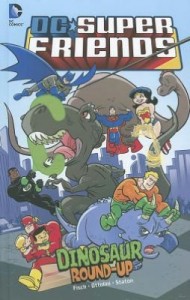Review: DC Super Friends
 Among the latest offerings from Capstone’s fruitful relationship with DC Comics are a line of hardcovers reprinting some of the latter’s kid-friendly comics. Not collections of groups of comics, but single-issue reprints, differentiated from the original comics only by their hard, sturdy covers and spines—actual comic books never seem to last long in libraries, no matter how much tape is applied, do they?—as well as a lack of ads and some age-appropriate back matter.
Among the latest offerings from Capstone’s fruitful relationship with DC Comics are a line of hardcovers reprinting some of the latter’s kid-friendly comics. Not collections of groups of comics, but single-issue reprints, differentiated from the original comics only by their hard, sturdy covers and spines—actual comic books never seem to last long in libraries, no matter how much tape is applied, do they?—as well as a lack of ads and some age-appropriate back matter.
There are several different titles in the line, which we’ll be taking a look at over the coming weeks. Let’s start with the one most suited for the youngest readers, however: DC Super Friends.
The DC Super Friends comic initially launched in 2008 as part of a new, revitalized “Johnny DC” line of kids’ comics, along with Tiny Titans and Billy Batson and the Magic of Shazam. The book was based on Mattel’s line of Super Friends action figures, which featured thick, stocky, muscular versions of six of DC’s most popular heroes, with big hands, feet and heads: Superman, Batman, Wonder Woman, Aquaman, The Flash and Green Lantern John Stewart (as in the Justice League cartoon).
The comic book was perhaps the only one in DC’s kids line directed so squarely at young readers that it could prove alienating to adult readers, and was more of a kids comic than an all-ages one like, say, Billy Batson or some of their based-on-a-cartoon comics. Sholly Fisch, a versatile and prolific comics scripter, was responsible for writing, which focused on the heroes as rescuers and catchers-of-bad guys more than fighters, and art varied from issue to issue, with the artists hewing as close as possible to the thick, squat designs established by the toy makers (Of the artists, cover artist and too-infrequent interior artist J. Bone generally handled the scripts best, perhaps because his simplified, thickened figures naturally over-lapped with the toy designs more easily than the personal style of some of the other artists).
Capstone’s reprint the first four issues of the series, all written by Fisch and drawn by Dario Brizuela, Stewart McKenny and Philip Moy and Joe Staton and Horacio Ottolini. The reprints are sans issue numbers, which they don’t really need—every issue of the series was a self-contained story, and there was no issue-to-issue continuity readers needed to keep in mind.
In Dinosaur Round-Up, Staton and Ottolini draw an adventure mixing two-thirds of the Holy Trinity of little boys’ interests, superheroes and dinosaurs. If they could have worked some trucks into this story, it would have been perfect.
 Some Metropolis-based scientists invent a portal that allows them to explore the Jurassic Period, two hundred million years in the past! While they journey to the past, a herd of dinosaurs discover the time portal works both ways, and they decide to explore the present, causing plenty of property damage and scaring people in the process. The Super Friends swoop in to captures all the errant dinosaurs and send them back where they belong.
Some Metropolis-based scientists invent a portal that allows them to explore the Jurassic Period, two hundred million years in the past! While they journey to the past, a herd of dinosaurs discover the time portal works both ways, and they decide to explore the present, causing plenty of property damage and scaring people in the process. The Super Friends swoop in to captures all the errant dinosaurs and send them back where they belong.
In Wanted: The Super Friends, old Justice League villain Felix Faust appears in a story apparently inspired by one of the more memorable Justice League of America covers from way back in 1962. Using magical finger puppets of the Super Friends as something akin to voodoo dolls, the wicked magician is able to control the heroes’ actions, and he uses them to gather three powerful magical artifacts. Inspired by one of their fans, however, they find a way to trick the villain. (That fan gets the nickname “Snapper,” one of several references in this book to the Silver Age Justice League.)
The other books are Hungry For Power and April Fools, the first and fourth issues of the comic, respectively. In the former, the Friends run afoul of Professor Ivo and his android Amazo. In the latter, the Friends come into conflict with The Jesters League of America, which is full of clownish villains like The Joker, Harley Quinn, Trickster, Prankster and Punch and Jewlee.
Each volume ends with biographies of the six heroes and the creators involved, some activities, a glossary of vocabulary (satellite, wizard, kryptonite, brachiosaurus, etc) with definitions and pronunciation and discussion questions about the story.
The books are suggested for readers 7 to 9 but are probably A-OK for kids just starting to read, particularly if they’re already superhero fans.
![]()
![]()
![]()
![]()
![]()
![]()
![]()
RELATED
The job outlook in 2030: Librarians will be in demand
The job outlook in 2030: Librarians will be in demand
ALREADY A SUBSCRIBER? LOG IN
We are currently offering this content for free. Sign up now to activate your personal profile, where you can save articles for future viewing






Add Comment :-
Be the first reader to comment.
Comment Policy:
Comment should not be empty !!!